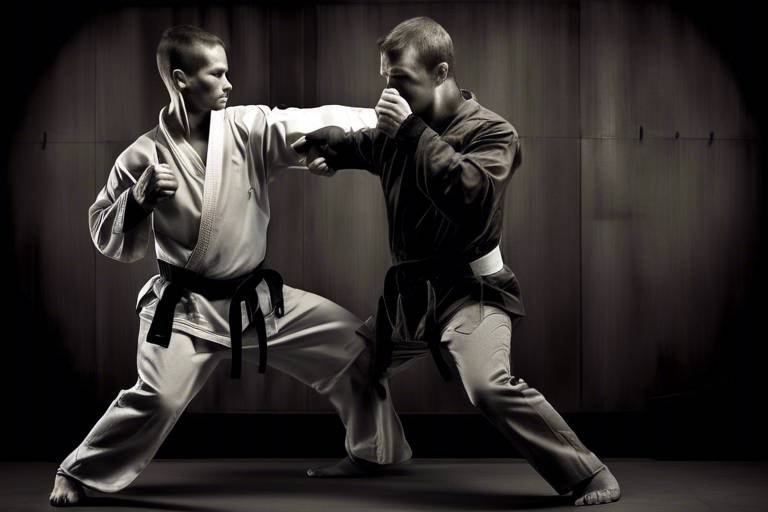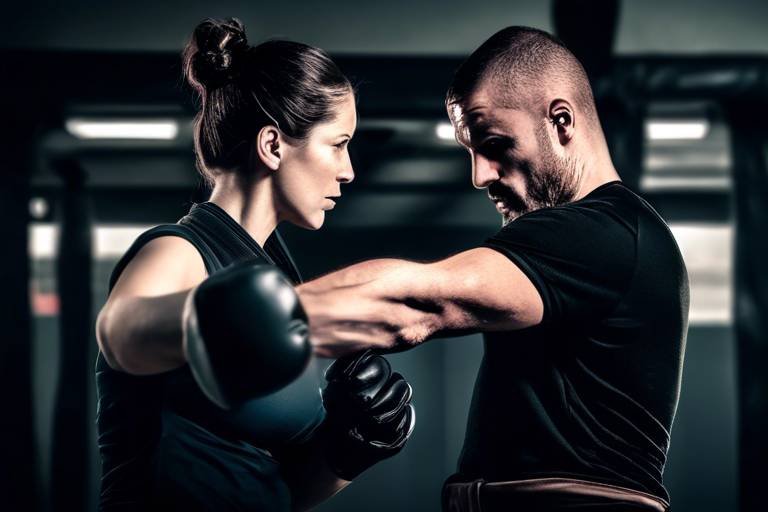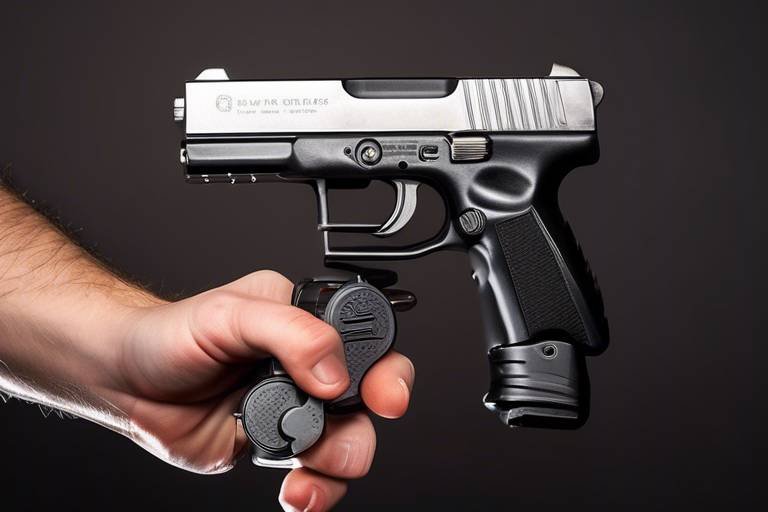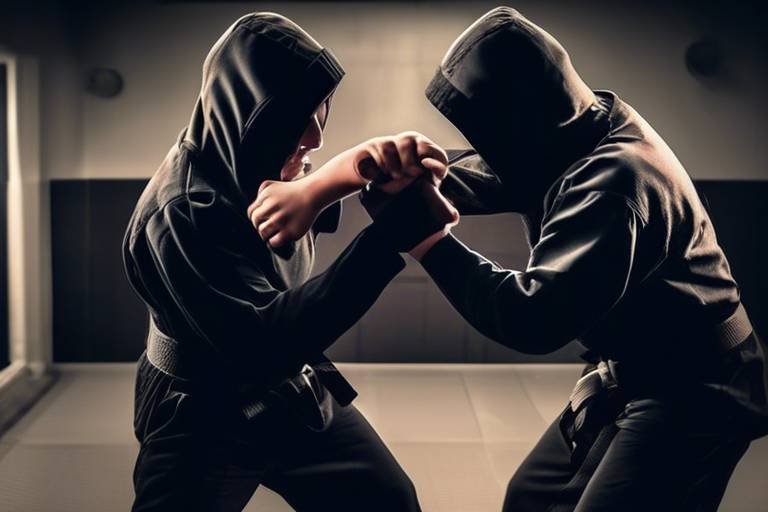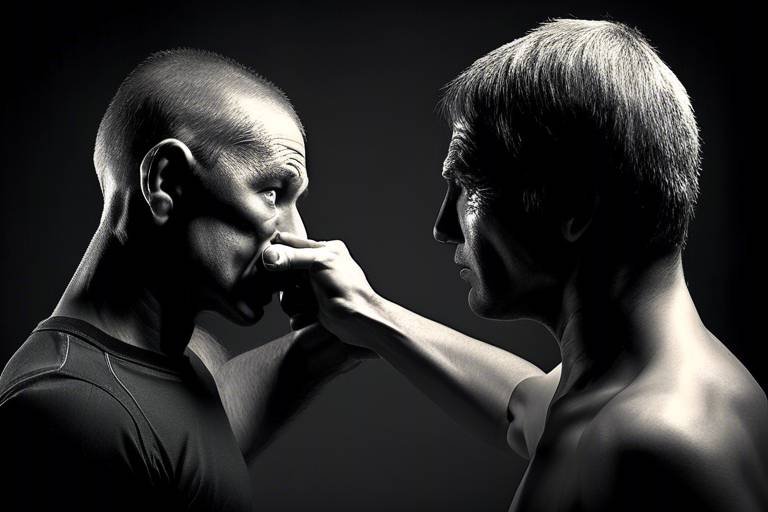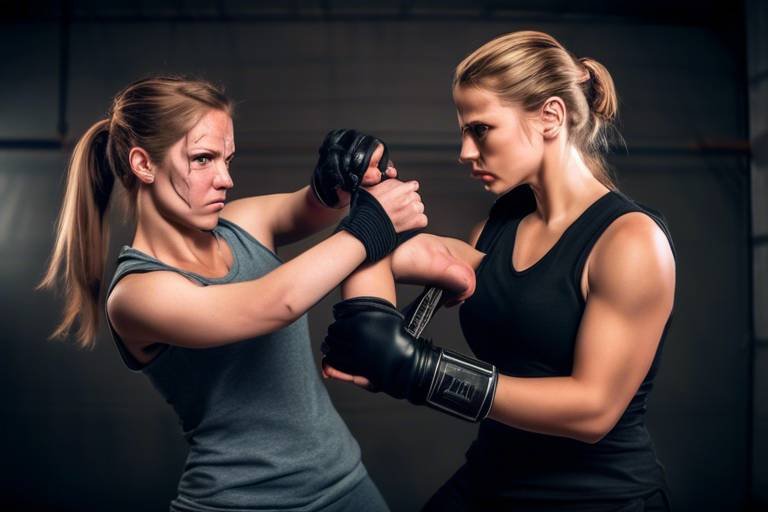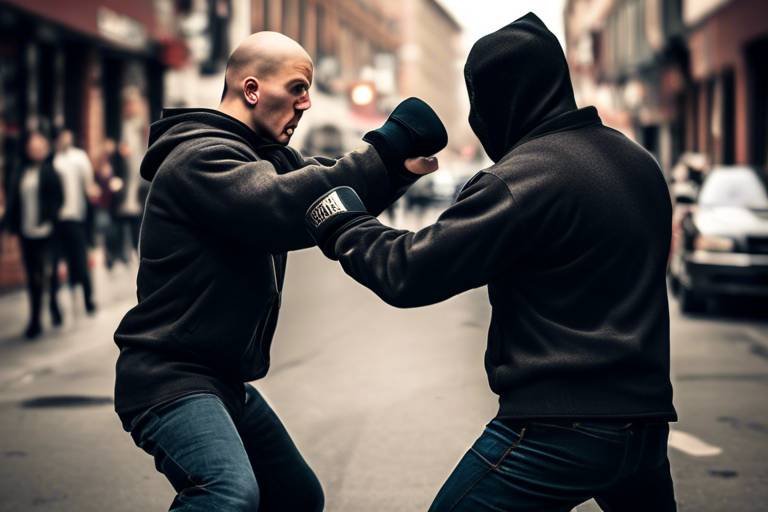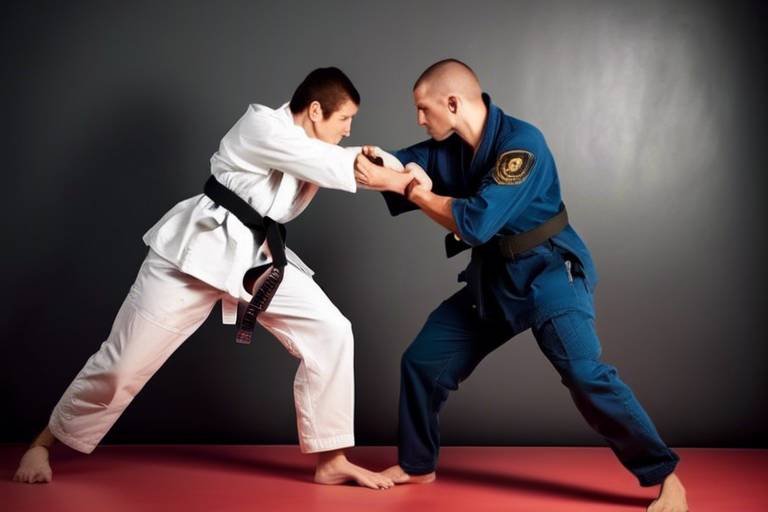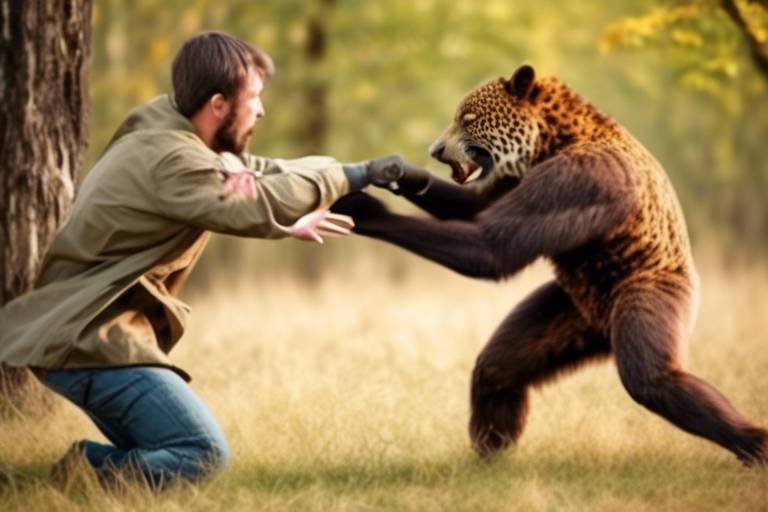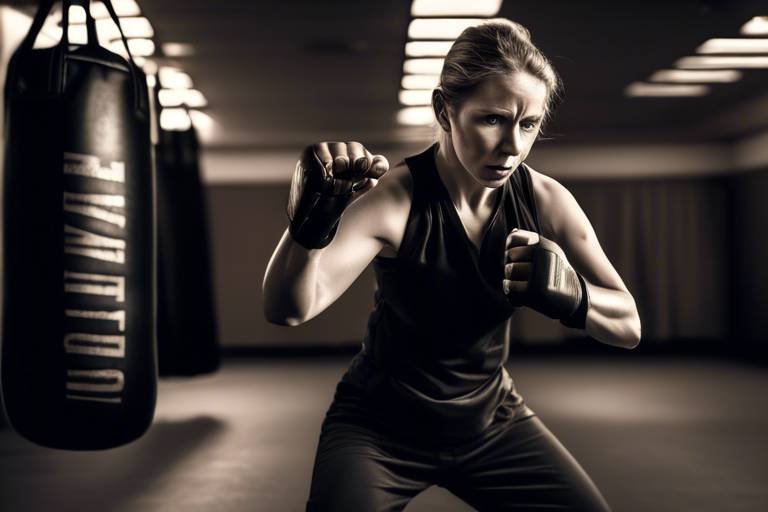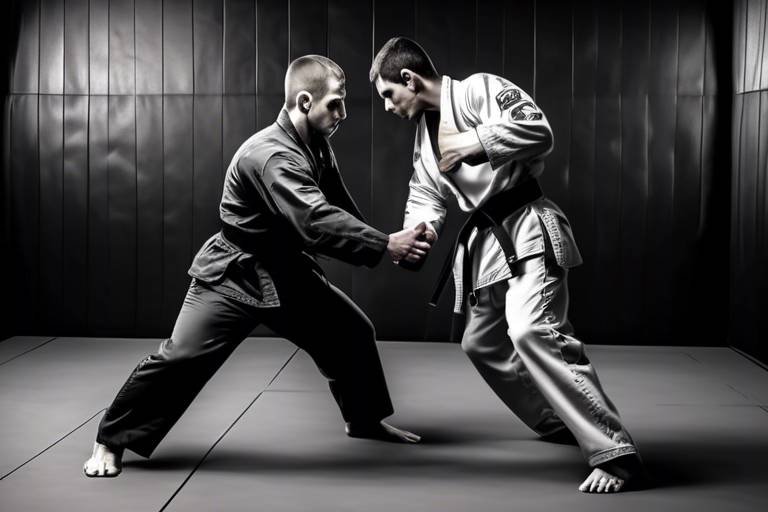Developing a Self-Defense Mindset - Techniques and Tips
In today's unpredictable world, cultivating a self-defense mindset is more crucial than ever. It’s not just about knowing how to fight; it's about understanding how to think and react in potentially dangerous situations. Imagine walking down a quiet street and suddenly feeling a sense of unease. What if you could turn that feeling into a powerful tool for your safety? This article delves into essential techniques and tips that can help you build that mindset, focusing on mental preparedness, situational awareness, and practical strategies that empower you to navigate various situations with confidence.
When we talk about self-defense, many people jump straight to physical techniques. However, the reality is that a strong mindset is your first line of defense. Mental preparedness means being ready to face challenges without panicking. Think of it like preparing for a big exam; you wouldn't walk in unprepared, right? Similarly, in self-defense, a well-prepared mind can help you remain calm and focused when it matters most. It allows you to make better decisions and respond effectively during a threatening situation. By training your mind to anticipate and handle danger, you can transform fear into confidence.
Situational awareness is your ability to perceive and understand your environment. It’s akin to being a detective in your own life. You should always be on the lookout for clues about what’s happening around you. This involves not just seeing but truly observing—paying attention to body language, recognizing potential threats, and assessing your escape routes. By honing this skill, you can significantly reduce your risk of becoming a victim.
Recognizing potential threats is vital for effective self-defense. Just like a hawk spots its prey from a distance, you need to learn to identify warning signs and behaviors that may indicate danger. Some common indicators include:
- Unusual behavior: Someone acting erratically or aggressively.
- Body language: Closed-off stances or excessive fidgeting can signal discomfort or hostility.
- Proximity: A person who invades your personal space without reason.
By staying alert and proactive, you can often avoid dangerous situations before they escalate.
To effectively develop a self-defense mindset, you must be adept at assessing your surroundings. This means regularly scanning your environment for unusual activities or individuals that might pose a risk. Picture yourself in a crowded place; do you know where the exits are? Are there any suspicious individuals nearby? By training yourself to constantly evaluate your environment, you can improve your chances of staying safe.
In the digital age, technology can be a valuable ally in maintaining situational awareness. There are various apps and devices designed to enhance personal safety. For example, personal safety apps can send alerts to friends or authorities with your location, while wearable devices can track your movements and alert you to potential dangers. By leveraging these tools, you can stay connected and informed, adding another layer of security to your self-defense strategy.
Having a response plan is essential for effective self-defense. Just like a fire drill prepares you for emergencies, a well-thought-out response plan can ensure that you act quickly and decisively when faced with a threat. Consider different scenarios you might encounter—walking home alone at night, being in a crowded space, or facing an aggressive individual. For each situation, think about:
- What actions can you take to protect yourself?
- Who can you reach out to for help?
- What routes can you take to escape?
By creating personalized strategies for various situations, you can enhance your ability to react effectively when necessary.
Now that we’ve covered the mental aspects, let's dive into practical self-defense techniques that you can learn and practice. These skills are not just about physical strength; they empower you to protect yourself if the need arises. Remember, self-defense is about being smart and resourceful.
Understanding basic self-defense moves can significantly boost your confidence. Techniques like the palm strike, knee strike, and escape from wrist grabs are fundamental skills that are easy to learn and can be applied in real-life situations. Think of these moves as your safety toolkit—simple yet effective tools that can help you get out of a sticky situation.
De-escalation techniques are vital for avoiding physical confrontations altogether. Sometimes the best defense is not to engage at all. This involves using verbal strategies and body language cues to diffuse potential conflicts before they escalate. For instance, maintaining a calm tone, showing open body language, and using phrases that acknowledge the other person's feelings can go a long way in reducing tension. Remember, your goal is to exit the situation safely, not to prove a point.
Q: Can anyone learn self-defense?
A: Absolutely! Self-defense is for everyone, regardless of age or physical ability. With the right mindset and training, anyone can learn to protect themselves.
Q: How long does it take to learn self-defense?
A: The time it takes varies based on the individual and the techniques being learned. However, even a few classes can provide valuable skills and confidence.
Q: Is self-defense only about physical techniques?
A: No, self-defense encompasses mental preparedness, situational awareness, and conflict de-escalation, in addition to physical techniques.
Q: What should I do if I feel threatened?
A: Trust your instincts. If you feel threatened, find a safe space, alert authorities, or use your personal safety apps if available.

The Importance of Mental Preparedness
Mental preparedness is the cornerstone of effective self-defense. Imagine standing in a crowded subway, and suddenly, you feel a sense of unease. Your heart races, and panic starts to creep in. This is where a strong mindset can be your best ally. When faced with potential threats, maintaining a calm and focused demeanor is crucial. It allows you to assess the situation clearly, make informed decisions, and respond appropriately. In essence, your mind can either be your greatest strength or your worst enemy in moments of crisis.
Why is mental readiness so important? Well, think of it this way: if you were to face an unexpected situation, would you rather be a deer caught in headlights or a seasoned firefighter ready to tackle a blaze? The latter embodies the essence of mental preparedness. It’s about training your mind to remain composed under pressure, allowing you to act rather than react. This proactive approach can significantly enhance your ability to protect yourself and those around you.
To cultivate a self-defense mindset, consider these key components:
- Self-Awareness: Knowing your strengths and weaknesses can help you prepare mentally for various scenarios.
- Visualization: Picture yourself in different situations and rehearse your responses. This mental rehearsal can make a significant difference when the time comes to act.
- Stress Management: Techniques such as deep breathing, meditation, or mindfulness can help you stay calm and centered, even in high-stress situations.
Moreover, it's essential to understand that mental preparedness is not just about being ready for physical confrontations. It's also about being equipped to handle emotional and psychological challenges that may arise. For instance, in a heated argument, being mentally prepared can help you de-escalate the situation rather than escalate it into a physical altercation. This holistic approach to self-defense emphasizes the importance of being aware of your emotional state and how it influences your actions.
In conclusion, developing a self-defense mindset rooted in mental preparedness is not just an option; it’s a necessity. It empowers you to navigate through life's uncertainties with confidence and resilience. By investing time in strengthening your mental fortitude, you are not only preparing yourself for potential threats but also enhancing your overall quality of life. So, take a moment to reflect on your mental readiness today—because when it comes to self-defense, your mind is your first line of defense.

When it comes to self-defense, one of the most powerful tools in your arsenal is situational awareness. This means being fully aware of your surroundings and understanding what's happening around you. It's not just about seeing; it's about observing and interpreting what you see. Think of it like a chess game where you need to anticipate your opponent's moves before they make them. By honing your situational awareness, you can identify potential threats and react appropriately, giving you a significant advantage.
To enhance your situational awareness, start by practicing the following techniques:
- Observe Body Language: Pay attention to the non-verbal cues of people around you. Are they agitated? Is someone lurking too close for comfort? Understanding body language can give you critical insights into a person's intentions.
- Identify Potential Threats: Always be on the lookout for anything out of the ordinary. This could be someone acting suspiciously in a public space or a group of people who seem overly aggressive. Being proactive rather than reactive can be the difference between safety and danger.
- Assess Escape Routes: Wherever you go, make a mental note of exits and safe places. If you find yourself in a precarious situation, knowing your escape routes can help you act quickly and decisively.
Moreover, situational awareness isn't just about being alert; it's about being prepared. For instance, when you enter a new environment—be it a restaurant, park, or even your workplace—take a moment to scan the area. Look for exits, potential hiding spots, and any individuals who might seem out of place. This practice can become second nature with time and can significantly enhance your safety.
One of the cornerstones of situational awareness is the ability to identify threats. It’s essential to recognize common warning signs that may indicate danger. For example, if you notice someone following you too closely or if a group of individuals is behaving aggressively, these are red flags. By staying vigilant and recognizing these signs early, you can take necessary precautions to protect yourself.
To develop an effective self-defense mindset, you need to regularly assess your environment. This means scanning your surroundings for unusual activities or individuals that may pose a risk. Ask yourself questions like: "Do I feel comfortable here?" or "Is there anything that seems off?" This constant evaluation will help you remain alert and ready to react if necessary.
In today's digital age, technology can be your ally in maintaining situational awareness. There are numerous apps and devices designed to enhance personal safety. For instance, personal safety apps can alert trusted contacts if you're in danger or provide your location in real-time. Additionally, wearable devices like smartwatches can send emergency notifications with just a tap. Leveraging technology not only keeps you informed but also empowers you to take control of your safety.
In conclusion, developing situational awareness techniques is a vital aspect of cultivating a self-defense mindset. By learning to observe your surroundings, identify potential threats, and utilize technology, you can enhance your personal safety and confidence in various situations. Remember, being aware is the first step in protecting yourself.
What is situational awareness?
Situational awareness is the ability to perceive and understand your surroundings, which helps you identify potential threats and react accordingly. It's about being aware of what's happening around you, not just physically, but also emotionally and socially.
How can I improve my situational awareness?
You can improve your situational awareness by practicing observation skills, assessing your environment regularly, and being mindful of the people around you. Engaging in activities that require attention to detail, like playing strategy games, can also help.
Are there any apps to help with situational awareness?
Yes, there are several personal safety apps available that can help you stay aware of your surroundings and alert your contacts in case of an emergency. Examples include bSafe, Life360, and Noonlight.

When it comes to self-defense, the first line of protection is awareness. Recognizing potential threats is a skill that can be developed over time. Just like a hawk soaring high above the ground, you need to have an eagle eye for detail. This means being attuned to your surroundings and the people within them. It’s not about being paranoid but rather about being prepared. Start by observing the individuals around you: their body language, facial expressions, and even their posture can reveal a lot about their intentions.
For instance, someone who is constantly looking over their shoulder, fidgeting, or avoiding eye contact may be exhibiting signs of nervousness or ill intent. Conversely, a confident individual will likely maintain a relaxed posture and engage with their environment openly. Understanding these cues can help you identify potential threats before they escalate. Moreover, it’s essential to trust your instincts. If something feels off, it probably is. Your gut feeling is a powerful tool, and ignoring it can lead to dangerous situations.
In addition to observing people, pay attention to your physical environment. Are there any unusual activities happening? Is there a group of people loitering in an area where they shouldn't be? These could be red flags. Take a moment to assess the situation and consider the context. For example, if you notice someone pacing back and forth while frequently checking their phone, they may be waiting for something or someone. This behavior could indicate that they are up to no good, especially if they are in a location that seems out of place.
To help you identify potential threats more effectively, here are some common warning signs to keep in mind:
- Inconsistent behavior: Someone acting differently than the situation warrants.
- Overly aggressive body language: Clenching fists, glaring, or invading personal space.
- Unusual attire for the environment: Wearing heavy clothing in warm weather or covering their face.
Remember, threat identification is not about creating a sense of fear but about fostering a sense of security through preparedness. By honing your ability to spot potential dangers, you empower yourself to take action or avoid risky situations altogether. In the end, it’s all about enhancing your self-defense mindset and ensuring that you can navigate the world confidently.

When it comes to self-defense, one of the most crucial skills you can develop is the ability to assess your environment. Imagine walking into a crowded room; it's not just about getting from point A to point B. It's about being aware of your surroundings and understanding how they can impact your safety. By sharpening your observational skills, you can identify potential threats and make informed decisions. So, how do you effectively assess your environment? Let’s dive in.
First, you need to adopt a 360-degree awareness approach. This means not only focusing on what’s directly in front of you but also scanning your peripheral vision. Think of it like being a hawk; you want to have a wide field of vision to spot anything unusual. Look for signs of discomfort in people around you, such as fidgeting or avoiding eye contact, which can indicate that something isn’t quite right.
Next, consider the layout of your surroundings. Are there exits nearby? Are the pathways clear? Familiarizing yourself with your environment can make a significant difference in a high-stress situation. For instance, if you're in a mall, know where the nearest exits are located. This mental map can help you escape quickly if necessary. Here are a few key points to keep in mind:
- Identify exits: Always know how to get out of a situation as quickly as possible.
- Observe behavior: Watch how people interact; unusual behavior can be a red flag.
- Scan for obstacles: Be aware of anything that could impede your movement, such as furniture or large crowds.
Additionally, it's vital to recognize unusual activities in your environment. If you see someone acting strangely—perhaps pacing back and forth or watching others too intently—trust your instincts. Your gut feeling is often your first line of defense. Remember, it's better to be overly cautious than to ignore a potential threat.
Finally, don't forget about the power of technology in assessing your environment. Many apps can help you stay aware of your surroundings, providing alerts for nearby incidents or emergencies. For instance, personal safety apps can share your location with trusted contacts or alert authorities if you're in danger. Integrating technology into your self-defense strategy can enhance your situational awareness, making you feel more secure in any environment.
In conclusion, assessing your environment is about more than just looking around; it's a comprehensive approach that combines observation, intuition, and technology. By honing this skill, you’ll not only improve your self-defense capabilities but also boost your confidence in navigating various situations. So, the next time you step out, remember to assess, be aware, and stay safe!

In our fast-paced world, technology has become an indispensable ally when it comes to enhancing our self-defense mindset. Imagine walking down a busy street, your senses heightened, but also armed with the latest tech tools that keep you informed and alert. This combination of **awareness and technology** can significantly boost your confidence and safety. From smartphone apps to wearable devices, the right technology can help you stay one step ahead of potential threats.
One of the most effective tools at your disposal is a **personal safety app**. These apps can provide real-time alerts about nearby incidents, share your location with trusted contacts, and even allow you to send out distress signals with just a tap. Some popular apps include:
- SafeTrek: This app lets you hold down a button while walking in potentially dangerous areas. If you release the button without entering your PIN, authorities are notified of your location.
- bSafe: This app allows users to create a network of friends and family who can be alerted in case of an emergency. It also features a built-in SOS button that immediately sends your location.
- Life360: A family locator app that shares real-time location information with your loved ones, ensuring that someone always knows where you are.
Moreover, wearable technology such as smartwatches can also play a crucial role in personal safety. Many smartwatches now have built-in emergency features, allowing you to contact emergency services quickly. For instance, the Apple Watch has a feature that automatically calls emergency services if it detects a hard fall. This can be a lifesaver in critical situations when every second counts.
Another exciting development is the use of **drones** for personal safety. While this might sound like something out of a sci-fi movie, drones equipped with cameras can be deployed in certain environments to provide a bird's-eye view of your surroundings, allowing you to spot potential threats before they become a problem. Though this technology is still evolving, it showcases the innovative ways we can enhance our situational awareness.
Additionally, **security cameras** and smart home devices can help monitor your surroundings, whether at home or out in public. With features like motion detection and remote access, these devices can alert you to unusual activities, giving you the upper hand in assessing your environment. Imagine receiving a notification on your phone when someone approaches your front door while you're away—this technology can make all the difference in staying safe.
However, it's essential to remember that while technology can enhance your awareness, it shouldn't be your sole reliance for safety. The best approach is to combine these technological tools with traditional self-defense techniques and mental preparedness. This holistic strategy ensures that you are not only aware of your surroundings but also equipped to handle any situation that may arise.

When it comes to self-defense, having a well-thought-out response plan can make all the difference between panic and decisive action. Imagine you're walking in a park, and suddenly, you sense that something feels off. Your heart races, and your mind goes blank. This is where a response plan becomes your best friend. It’s not just about knowing how to throw a punch or escape a hold; it’s about being mentally prepared for various scenarios. By developing a personalized response plan, you can ensure that you have a clear path of action, which can significantly enhance your confidence and safety.
First, let’s talk about the importance of tailoring your plan to your specific circumstances. Not every situation is the same, so it’s essential to consider factors such as your environment, the time of day, and the likelihood of encountering a threat. For example, if you often walk home late at night, your response plan might include avoiding poorly lit areas or having a trusted friend on speed dial. On the other hand, if you’re in a crowded space, your plan could focus on identifying exits and potential safe zones.
Creating a response plan involves several steps:
- Identify Potential Scenarios: Think about the types of situations you might encounter. This could range from a verbal confrontation to a physical threat.
- Assess Your Resources: Consider what tools or skills you have at your disposal. This could include self-defense techniques you've learned, personal alarms, or even items in your bag that could be used for protection.
- Practice Your Responses: Just like any skill, the more you practice your response plan, the more instinctual it will become. Role-playing different scenarios with a friend can be a fun and effective way to prepare.
Moreover, visualize your response plan in action. Visualization is a powerful technique used by athletes and performers alike. By mentally rehearsing your plan, you can help your brain become familiar with the actions you need to take, making it easier to execute them under pressure.
Also, don't forget to stay flexible. Your response plan should be a living document, adaptable to new information or experiences. If you find that a particular strategy isn’t working for you, don’t hesitate to modify it. The goal is to create a plan that feels right for you and empowers you to act confidently.
Finally, consider sharing your response plan with trusted friends or family members. This not only holds you accountable but also ensures that those close to you are aware of how to assist you in a crisis. Having a support system can be incredibly reassuring, knowing that you’re not alone in your efforts to stay safe.
| Question | Answer |
|---|---|
| What should I include in my response plan? | Your response plan should include potential scenarios, resources available to you, and practiced responses for each situation. |
| How often should I review or practice my response plan? | It's a good idea to review your plan regularly and practice it at least once every few months, or more frequently if you feel it's necessary. |
| Can I use technology in my response plan? | Absolutely! Consider using safety apps, personal alarms, or even a GPS tracker that can help you stay connected with trusted individuals. |

When it comes to self-defense, having a few practical techniques up your sleeve can make all the difference. Think of it like having a toolbox filled with essential tools; each technique serves a specific purpose and can be invaluable in a moment of need. The beauty of these self-defense techniques is that they are not just about brute strength; they focus on using your body effectively and understanding your surroundings. This empowers you to respond confidently and decisively in threatening situations.
One of the most fundamental self-defense moves is the palm strike. This technique is not only simple to execute but also highly effective. Rather than using your fist, which can lead to injuries, the palm strike allows you to deliver a powerful blow to an assailant’s face or chest. Imagine striking with the heel of your palm; it’s like a hammer hitting a nail. The goal is to create enough impact to stun your attacker and give you a chance to escape.
Another essential technique is the knee strike. This move is particularly useful when someone is in close proximity to you. By lifting your knee and driving it into your opponent’s groin, you can incapacitate them momentarily. It’s a bit like using your body as a spring; the more force you generate, the more effective the strike will be. This technique not only targets a vulnerable area but also allows you to follow up with an escape.
In addition to these physical techniques, understanding the role of de-escalation is crucial. Sometimes, the best self-defense is avoiding a confrontation altogether. De-escalation techniques involve using your words and body language to diffuse a potentially dangerous situation. Imagine being in a heated argument; instead of raising your voice, you take a deep breath and speak calmly. This approach can often prevent a situation from escalating into violence.
To help you grasp the importance of these techniques, consider the following table that summarizes the key moves and their applications:
| Technique | Description | Application |
|---|---|---|
| Palm Strike | A powerful strike using the heel of your palm. | Effective against an attacker’s face or chest. |
| Knee Strike | A sharp upward strike targeting the groin. | Useful in close-range encounters. |
| De-escalation | Using calm words and body language to diffuse tension. | Prevents situations from escalating into violence. |
As you practice these techniques, remember that repetition is key. Just like learning to ride a bike, the more you practice, the more natural it becomes. You might even consider enrolling in a self-defense class, where you can learn these moves in a safe environment with professional guidance. Not only will you learn how to defend yourself, but you’ll also build confidence and awareness that can be invaluable in your daily life.
So, whether you’re walking in a dimly lit area or simply want to feel more secure in your daily routine, these practical self-defense techniques can provide you with the tools you need. They are not just about physical strength; they are about confidence, awareness, and the ability to make quick decisions. Remember, it’s not just about fighting back; it’s about being prepared and knowing how to protect yourself effectively.
Q: Do I need to be physically strong to defend myself?
A: Not at all! Self-defense techniques often rely on leverage and strategy rather than brute strength. Many effective moves can be executed by individuals of any size.
Q: Can I learn self-defense online?
A: While online resources can be helpful, it’s best to complement them with in-person training to practice techniques safely and effectively.
Q: What if I’m not comfortable with physical confrontation?
A: That’s perfectly fine! Focus on de-escalation techniques and situational awareness, which can help you avoid confrontations altogether.

When it comes to self-defense, having a few basic moves in your arsenal can make all the difference. Think of it like having a trusty toolbox; you may not need every tool all the time, but when the situation arises, having the right one can be a game-changer. These fundamental techniques are designed to be simple yet effective, allowing anyone to apply them in real-life situations.
First and foremost, it’s essential to understand the concept of distance management. Maintaining the right distance from a potential threat can give you the upper hand. For instance, if someone approaches you aggressively, stepping back can create space, allowing you to assess the situation better. This fundamental principle helps you control the interaction, giving you time to decide whether to engage or escape.
One of the most effective self-defense moves is the palm strike. This technique is not only easy to execute but also incredibly powerful. By using the base of your palm, you can strike an assailant's nose or chin, causing disorientation. Imagine swinging a hammer; the force comes from the base, not the tip. The same principle applies here. To perform a palm strike:
- Stand with your feet shoulder-width apart.
- Raise your dominant hand, keeping your fingers curled.
- With a quick motion, thrust your palm forward into the target.
Another essential move is the knee strike. This technique is particularly useful if someone is trying to grab or overpower you. By driving your knee into their groin, you can create an opportunity to escape. It’s like hitting a reset button; the sudden pain can momentarily incapacitate the attacker, allowing you to make your getaway. To perform a knee strike:
- Get into a stable stance.
- Pull your knee up towards your chest.
- Drive it forward into the target’s groin area.
Don't underestimate the power of a good shout either! In many self-defense scenarios, making noise can attract attention and deter an attacker. Think of it as your alarm system; the louder you are, the more likely someone will notice and intervene. A simple, loud "NO!" or "HELP!" can make a significant difference.
For those who may be more physically inclined, learning a basic escape maneuver can also be beneficial. If someone grabs your wrist, instead of pulling away—which can often tighten their grip—try to rotate your wrist towards their thumb. This motion takes advantage of the natural weakness in their grip. Remember, it’s all about using their strength against them.
Incorporating these basic self-defense moves into your routine can significantly boost your confidence and preparedness. However, practice is key. Just like learning to ride a bike, the more you practice, the more instinctive these moves will become. Consider enrolling in a self-defense class or practicing with a friend to hone your skills.
In summary, having a few basic self-defense moves can empower you to respond effectively in threatening situations. Remember, self-defense is not just about physical techniques; it’s about being aware, staying calm, and knowing how to act when it matters most. So, are you ready to take charge of your personal safety?
Q: Do I need to be physically strong to defend myself?
A: Not at all! Self-defense is more about technique and strategy than brute strength. Many effective moves rely on leverage and timing.
Q: Can I learn self-defense online?
A: Yes! There are many online resources, videos, and courses that can teach you basic self-defense techniques. However, practical experience is invaluable, so consider combining online learning with in-person classes.
Q: What should I do if I feel threatened?
A: Trust your instincts. If you feel uncomfortable, try to remove yourself from the situation if possible. Use your voice to attract attention and assert your boundaries.
Q: Are self-defense classes worth it?
A: Absolutely! Self-defense classes not only teach you valuable skills but also boost your confidence and situational awareness.

When it comes to self-defense, the first instinct for many might be to prepare for a physical confrontation. However, the reality is that de-escalation plays a pivotal role in preventing conflicts from turning violent. Imagine walking into a crowded room where tensions are high; your ability to recognize and diffuse the situation can make all the difference. Rather than jumping into a fight, employing de-escalation techniques can help you navigate potentially dangerous scenarios with greater finesse and safety.
De-escalation is all about calming down a heated situation before it escalates into something more serious. This involves not just verbal communication but also your body language and emotional intelligence. The goal is to create a space where both parties feel heard and respected, which can often lead to a peaceful resolution. For instance, using a calm tone of voice and maintaining open body language can significantly reduce the tension in a heated argument. Think of it as being a peacekeeper rather than a warrior; your aim is to bring harmony rather than chaos.
Here are some effective strategies to consider when practicing de-escalation:
- Active Listening: Make a conscious effort to listen to what the other person is saying. Sometimes, people just want to feel understood.
- Empathy: Show genuine concern for the other person's feelings. Acknowledging their emotions can help lower defenses.
- Maintain Composure: Your calm demeanor can have a soothing effect on the situation. If you remain relaxed, it encourages others to do the same.
- Use Non-Threatening Body Language: Keep your hands visible and avoid crossing your arms; this signals that you are not a threat.
It's important to remember that not every situation can be de-escalated, but having these techniques in your toolkit can greatly enhance your chances of avoiding a physical confrontation. The key is to practice these skills regularly, so they become second nature. Just like any other skill, the more you practice, the better you will become at recognizing the signs of escalating tension and knowing how to respond effectively.
In summary, de-escalation is an invaluable tool in the realm of self-defense. It empowers you to take control of a situation without resorting to violence. By fostering an environment of communication and understanding, you not only protect yourself but also contribute to a safer community. So, the next time you find yourself in a potentially volatile situation, remember that sometimes the best defense is a good conversation.
Q: What is de-escalation in self-defense?
A: De-escalation refers to techniques used to reduce tension and prevent a situation from escalating into violence.
Q: Can de-escalation techniques be learned?
A: Yes, de-escalation techniques can be learned and practiced, enhancing your ability to handle conflicts peacefully.
Q: Are there situations where de-escalation won't work?
A: While de-escalation is effective in many scenarios, there are instances where it may not be possible, especially if the other party is intent on violence.
Q: How can I practice de-escalation techniques?
A: You can practice by role-playing scenarios with friends or family, focusing on using calm language and body cues.
Frequently Asked Questions
- What is a self-defense mindset?
A self-defense mindset is the mental preparedness and awareness that enables individuals to respond effectively to potential threats. It involves staying calm, focused, and ready to act when faced with danger.
- Why is mental preparedness important for self-defense?
Mental preparedness is crucial because it allows you to remain composed during stressful situations. This clarity helps you make better decisions, assess risks accurately, and respond appropriately to threats.
- What are some techniques to improve situational awareness?
Improving situational awareness can be achieved through various techniques, such as actively observing your surroundings, recognizing unusual behaviors, and identifying escape routes. It's about being present and attentive to what’s happening around you.
- How do I identify potential threats?
Identifying potential threats involves recognizing warning signs such as aggressive body language, unusual behavior, or individuals lingering in a suspicious manner. Trusting your instincts is key—if something feels off, it probably is.
- What role does technology play in enhancing situational awareness?
Technology can significantly enhance situational awareness through apps that provide safety alerts, GPS tracking, and emergency contacts. Devices like personal alarms or smartwatches can also help keep you connected and informed.
- How can I create a personal response plan for self-defense?
Creating a personal response plan involves assessing various scenarios you might face and developing strategies for each. Consider your environment, potential threats, and how you would react to different situations to ensure you’re prepared.
- What are some basic self-defense moves I should learn?
Some basic self-defense moves include strikes, kicks, and escapes from holds. Techniques like palm strikes to the nose or knee strikes to the groin are effective and easy to learn, empowering you to protect yourself if necessary.
- How can de-escalation techniques help in self-defense?
De-escalation techniques are vital for avoiding physical confrontations. By using calm verbal communication and positive body language, you can often diffuse a situation before it escalates into violence, keeping you and others safe.

